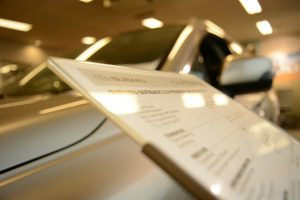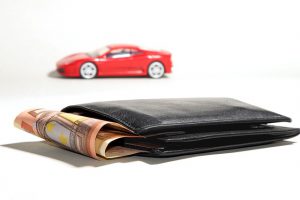The Car Buying Checklist
Buying a car is usually the first big purchase a person will make. A car loan is a type of consumer loan, also known as installment credit, where you borrow a lump sum and pay it back in fixed monthly payments. There is also no shortage of horror stories of people immediately regretting the decision, either by buying a new car and later struggling to meet payments, or a used car with hidden mechanical problems demanding costly repairs.
When you need to buy your first (or next) car, make sure these factors weigh in on your decision.
Establishing a Budget for Buying a Car
Before you get started, step one is establishing a budget for how much you want to spend on a vehicle. A common trap is picking the car you want first, then trying to find a way to pay for it.
Buying a car is not the same as buying a TV or most other big purchases. Your budget needs to factor in the life of the car’s loan, the interest rate you pay, and the cost of insurance. Most of these factors are negotiable, so it’s a good idea to establish your limits before walking into a dealership.
Car Loan Life and Interest Rate

When you get a car loan, the price you pay will be a combination of the sticker price, the interest rate of the loan, and the length of the loan. Car dealers want to make cars seem as affordable as possible. So during the negotiation process, they’ll focus on the monthly payment since this is the number in your budget. A smart shopper will know this is just a distraction.
Dealers want to lower your monthly payment to make the car seem affordable, so they might just extend the life of your loan. If you’re concerned about the initial sticker price, they might be happy to lower it by a few hundred dollars, but will increase your interest rate.
This means that while you’re looking to buy a car, you should have two budgets prepared. One is for the total cost of the car (including all interest payments over the life of the loan), and the other is how much you can afford in monthly payments. The dealer will always try to sell based on monthly payments alone, but make sure to keep the total cap in mind during negotiations. You can even keep a car loan calculator app on your phone as part of the discussion to keep both numbers in front of you.
Insurance Costs
The cost you’ll pay in car insurance depends on the car you buy. When examining your options for vehicles, remember that your insurance payments are for the life of the vehicle. Luckily, you can get multiple quotes for any vehicle within a few seconds from insurance comparison websites. Get two or three quotes for any vehicle you’re considering, and make sure it fits in your monthly budget.
New Vs Used
The first choice you make will probably be deciding if you want to buy a new or used car. There are some serious advantages and disadvantages of each, so keeping both in mind can end up saving a lot of money in the long run.
Depreciation and Resale

Cars lose value over time, but not at a constant rate. As soon as you drive a new car off the lot, it usually loses about 15% of its value (just because it’s no longer new). Cars also tend to lose value every year older they get, so by the end of your first year, your car could be down 30% of the sticker price.
On the other hand, used cars don’t have this problem. If you buy a used car and try to sell it the next day, you’ll probably get back about as much as you paid for it. Used cars also lose value over time, but the dollar amount lost is lower.
Example
Let’s compare two car buyers. One of them buys a new $30,000 car, while the other buys the same car three years later at its fair market value. This is what the resale value of the car would look like if each owner held their car for four years before trading it in.
| Resale Value | Sticker Price | Day 1 | Year 1 | Year 2 | Year 3 | Year 4 |
| New Car | $30,000.00 | $25,500.00 | $21,675.00 | $18,423.75 | $15,660.19 | $13,311.16 |
| Used Car | $15,660.19 | $ 15,660.19 | $13,311.16 | $11,314.49 | $9,617.31 | $8,174.72 |
We can look at the direct loss of value over time for each buyer as well:
| Loss of Value | Day 1 | Year 1 | Year 2 | Year 3 | Year 4 | Total Loss |
| New Car | ($4,500.00) | ($3,825.00) | ($3,251.25) | ($2,763.56) | ($2,349.03) | ($16,688.84) |
| Used Car | 0 | ($2,349.03) | ($1,996.67) | ($1,697.17) | ($1,442.60) | ($7,485.47) |
The used car buyer is saving $14,339.81 from the initial purchase price, and loses $9,203.37 less in depreciation over the life of the car.
Financing Charges
In most cases, new cars will have more flexible financing options than used cars, usually with much lower interest rates (nearly half!). This is important because used cars are so much cheaper. It’s rare for a potential buyer to look at the exact same car and decide whether to buy a new vs a used model. Instead, they usually compare an inexpensive new car versus a higher-quality used car.
Use the Car Loan Calculator to check how much it could cost to buy a new vs a used car.
Reliability and Warranties
The biggest difference between a new car and a used car is basic reliability. A new car will always have a manufacturer’s warranty, which covers nearly all repairs, replacements, and any mechanical problems with the car for the first three years. Used cars usually have no or very little warranty, pushing all of the risk of a breakdown onto the buyer. There are many databases available to help gauge the risk of a used car purchase, like the Federal Trade Commission Consumer Advice on Used Cars or ConsumerReports.org.
Before you buy a used car, it’s also a great idea to take the car to a mechanic for a check-up. Spending money on an inspection is far cheaper than replacing a transition a few months later!
Technologies and Mileage

One of the main reasons why people choose new cars is because of the improved technology that wasn’t available in the past. The same model of car will have new and better features, like better crash resistance, better gas mileage or driving assistance. New technologies are also introduced, like electric motors and self-driving options.
These features incentivize most buyers to spend more money on new cars. The new technology should enter your buying decision in two ways:
Directly Offsetting Cost
This is especially true for cars with better gas mileage, or electric motors. A small increase in gas mileage means it costs less to fill the tank every week, which adds up very quickly.
For 30,000 miles driven, a car with 30 mpg saves 1,200 gallons of gasoline compared to 25mpg!
Value of Technology
Finally, you can estimate how valuable the new technologies are to you. If you have a long commute every morning, you’ll probably put a high value on a self-driving car, allowing you to do other things. If you have a shorter commute, the technology is still valuable, but saves you less time and effort, so deserves less of your hard-earned cash.
Getting a Good Deal
When you’re at the dealership, your main concern is always getting a good deal. One of the oldest tricks in the book for car dealers is the 4-Square Presentation.
The 4 Square Presentation
A 4-Square Presentation divides your attention between the four factors impacting the sale:
- Sticker price
- Trade-In value of your current vehicle
- Down payment
- Monthly payment
One of the main goals of this technique is to keep your attention divided between these 4 areas instead of focusing on one at a time. Since most buyers are focused on making sure the car payments can fit into their monthly budget, dealers will move around the other squares to get the monthly payment down to what you can afford.
Unfortunately, the 4-Square Presentation does not focus on the items that you should be worrying about. Both your interest rate and the length of the loan are absent from the discussion; which is what really determines how much you pay over the life of the loan. There are a few ways to push the conversation back to the numbers that really matter.
Trade In vs Selling
Most people trade in their vehicle when buying a new one, and almost every dealership is happy to accommodate. However, you always have the option of selling your car yourself, which changes the nature of the discussion when talking with the dealer.
Resale Value

When you trade in your vehicle, the dealership will take your old car and either try to resell it themselves, put it up for auction, or scrap it entirely and sell off any working parts.
How much you can get reselling your car yourself vs trading it in to your dealer will depend largely on its condition. If your car is in good condition and is a popular model, you’ll likely have no trouble selling it on your own. You’ll likely make more money than if you trade it in. This is because the dealership needs to factor in the cost of selling your car when they give a trade-in offer. If they need to store it, clean it, and sell it, it takes some of their resources, which get deducted from your offer.
On the other hand, if your car is older with mechanical problems, trading it in might get you a better deal. It saves you the time of trying to sell it, and since the dealership already has established scrapping and resale networks, they’ll probably get a better price for the parts than you would alone. Even if you have an old junk car, your salesman will probably try to offer you a better deal just to get you to buy at his dealership.
Total Price
One of the main advantages of selling your car yourself is that it removes one of the key elements in your negotiation. Helping you turn the conversation back to loan terms, interest rates and the actual cost of buying the car. This is why it’s important to have the total budget in mind for how much you plan on spending on the vehicle in total, not just monthly payments. First, you should focus on lowering the sticker price and get this in writing as a quote. Once that is clearly established, then move the conversation to financing.
Financing Options
You’re not tied to financing your vehicle through the car dealership. The only advantage is usually the dealership will require you finance through them if you want to trade in your current vehicle. Yet another advantage of selling your car yourself! The financing is also where you need to be the most wary of your salesman.
Precomputed Interest
With most loans, you can increase your payments each month to pay off the loan sooner. This is usually not allowed with car loans that you get from the dealership, which use something called precomputed interest.
Precomputed interest means no matter how much you pay or how quickly, your total interest charged remains the same. This means there is no advantage of paying off your loan early, since you can never lower the interest payments.
You should avoid precomputed interest loans whenever possible. Ask your dealer up front if their loans use precomputed interest. If they only have precomputed interest financing options, then take out the loan from somewhere else (like your bank). Since you already got the sticker price negotiated, you can get your financing from anywhere with better terms.
Challenge Questions
- What are the advantages and disadvantages of buying a new car?
- In your opinion, is having a new or used car better for you and why?
- Using examples, what do you understand by the term depreciation?
- If you are to lease or take out a loan to buy a car, how does the down payment affect your payments?
- Would you rather have a bigger down payment and a smaller monthly payment, or a small down payment and a larger monthly payment?